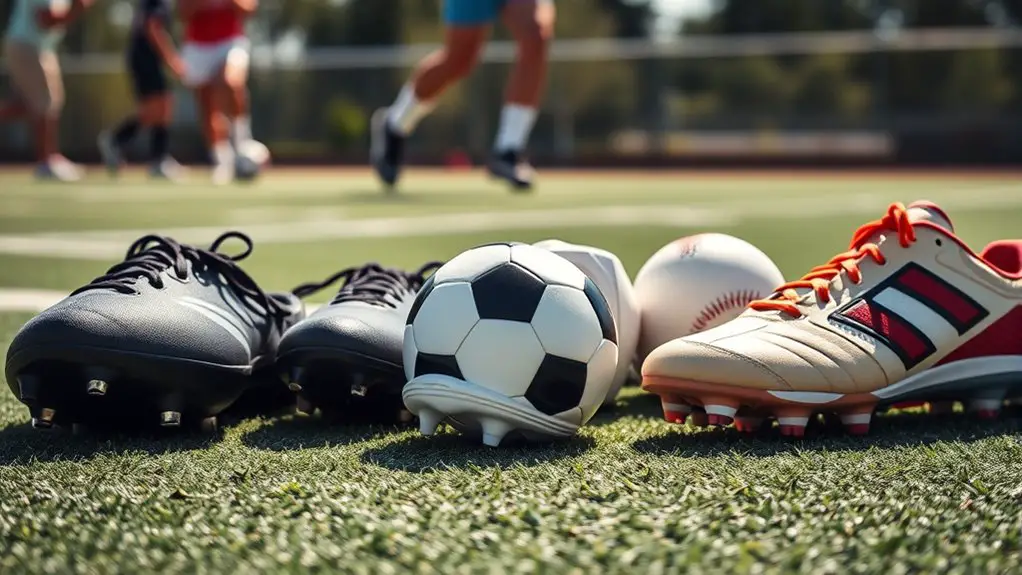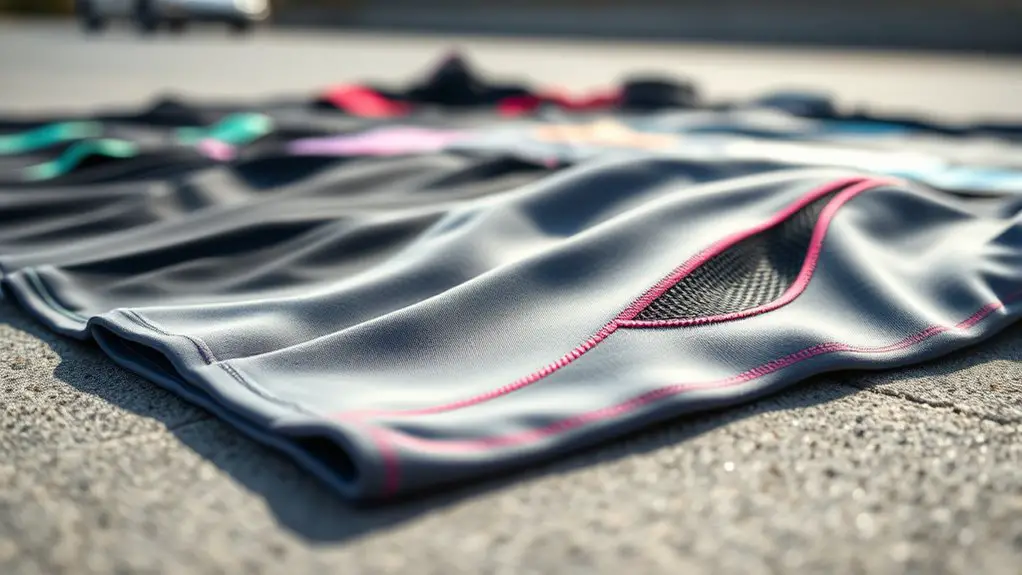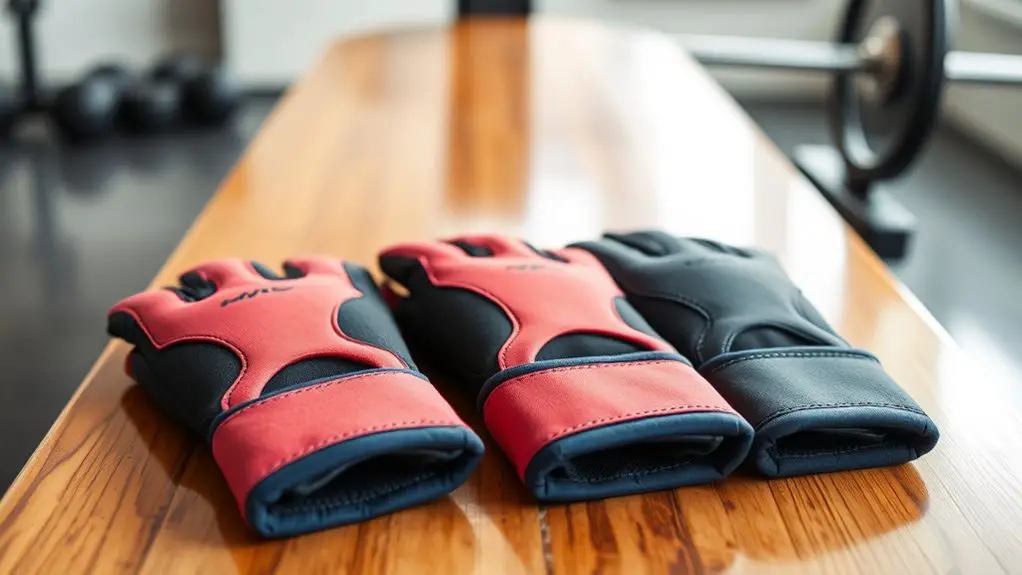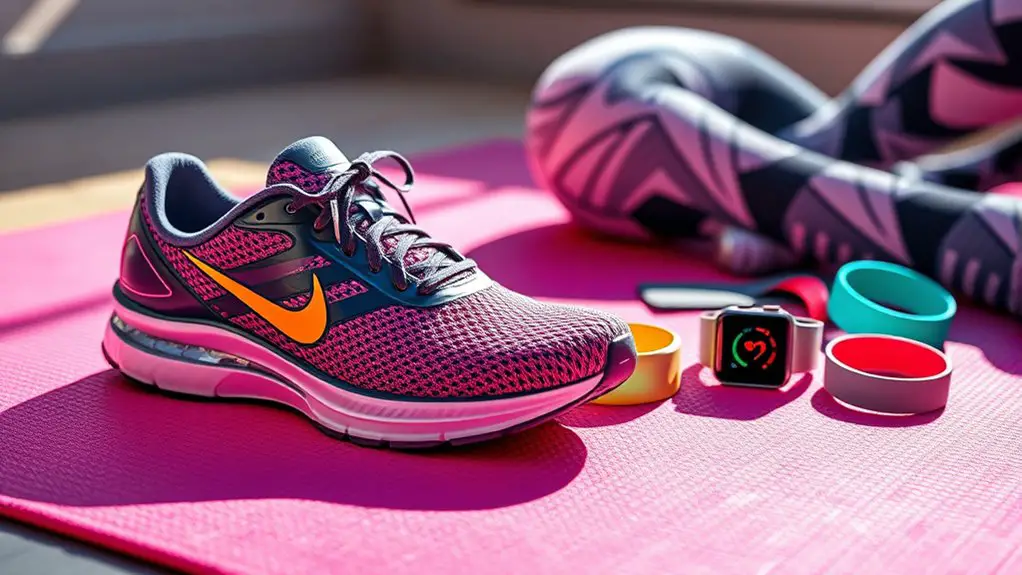The best weightlifting belts for powerlifters enhance strength, stability, and support during heavy lifts. Look for durable materials, like high-quality leather or sturdy synthetics, with a width of at least 4 inches for ideal lumbar support. Make sure it fits snugly just above your hips, allowing you to adjust for comfort. Popular options include both leather and moisture-resistant synthetic belts. Curious about the top five picks and how to maximize your experience with a weightlifting belt?
Understanding the Importance of a Weightlifting Belt
When you're pushing your limits in powerlifting, a weightlifting belt can be a game changer. It's not just about looking the part; it's about enhancing your strength and stability. By providing support to your core, a belt helps you lift heavier weights safely, allowing you to break through those plateaus. You'll find that the added compression encourages better intra-abdominal pressure, giving you the confidence to tackle challenging lifts.
Using a belt also reminds you of proper form, keeping your spine aligned and reducing the risk of injury. When you're aiming for freedom in your lifting journey, this tool isn't a crutch—it's an ally. It empowers you to explore your full potential while maintaining safety. So, when you're gearing up for your next session, remember that a weightlifting belt can be the key to revealing new levels of performance and freedom in your powerlifting endeavors.
Key Features to Look for in a Weightlifting Belt
When choosing a weightlifting belt, you'll want to take into account the material and durability to guarantee it lasts through your training sessions. The width and support levels are also essential, as they can greatly influence your performance and comfort. Let's look at these features more closely to help you make the best choice.
Material and Durability
Choosing the right weightlifting belt hinges on understanding its material and durability. You want a belt that can withstand the intense demands of your training without breaking down. Look for options made from high-quality leather or sturdy synthetic materials. Leather belts offer excellent durability and a classic feel, but they can take time to break in. Synthetic belts, on the other hand, often provide a lighter, more flexible option that can still deliver solid support. Check for reinforced stitching and robust buckles, as these features enhance longevity. A durable belt not only supports your lifts but also gives you the freedom to focus on pushing your limits, knowing your gear can handle the challenge.
Width and Support Levels
A weightlifting belt's width and support levels are essential for maximizing your performance during heavy lifts. When choosing a belt, consider one that's at least 4 inches wide for ideal lumbar support. This width provides stability without restricting your freedom of movement. A thicker belt can offer more rigidity, which is great for heavy squats and deadlifts, allowing you to push your limits confidently.
However, if you prefer a bit more flexibility, a tapered design might suit you better. It gives you support where you need it while allowing for better mobility. Ultimately, your choice should reflect your lifting style and personal comfort, ensuring you feel empowered and ready to conquer your goals.
Leather vs. Synthetic Belts: Which Is Right for You?
Which type of weightlifting belt suits your needs better: leather or synthetic? If you value durability and a classic feel, leather belts might be your best bet. They mold to your body over time, providing a snug fit that can enhance your stability during lifts. Plus, they often boast superior support, helping you push your limits. However, they can be heavier and take longer to break in.
On the flip side, synthetic belts offer flexibility and comfort right out of the box. They're generally lighter, making them a great choice if you favor a more dynamic lifting style. Plus, many synthetic options are moisture-resistant, so they'll handle sweat better.
Ultimately, it comes down to your personal preference and lifting style. Do you prioritize tradition and sturdiness, or are you more inclined toward comfort and convenience? Choose the one that aligns with your lifting journey!
Top 5 Weightlifting Belts for Powerlifting
When it comes to powerlifting, having the right gear can make a significant difference in your performance, and a good weightlifting belt is no exception. Here are five top choices that can elevate your lifting game.
- Inzer Forever Lever Belt – Known for its durability and support, this lever belt offers a secure fit and is easy to adjust.
- Rogue Ohio Belt – This belt combines comfort and stability, making it a popular choice among seasoned lifters.
- Titan Signature Series Belt – With a unique design, it provides excellent support while allowing freedom of movement.
- Schiek Sports Model 2004 – This belt features a patented design that conforms to your body shape, ensuring maximum comfort.
- Harbinger Padded Weightlifting Belt – For those who want extra cushioning, this option delivers support without sacrificing comfort.
Choose wisely, and feel the difference in your lifts!
How to Properly Fit and Adjust Your Weightlifting Belt
Fitting your weightlifting belt properly is essential for maximizing support and performance. You'll need to measure your waist size, position the belt correctly, and adjust the tightness to suit your needs. Let's explore each of these steps to guarantee you get the most out of your belt.
Measuring Your Waist Size
To guarantee your weightlifting belt provides the best support during your lifts, measuring your waist size accurately is essential. Start by grabbing a flexible measuring tape, and wrap it around your waist at the level where your belt will sit—typically just above your hip bones. Make sure it's snug but not too tight; you want an accurate measurement without compressing your body. Take note of the size in inches, and round it to the nearest whole number. When you've got your measurement, refer to the sizing chart of your chosen belt brand, as sizes can vary. Remember, a well-fitted belt can enhance your performance, giving you the freedom to lift with confidence.
Belt Positioning Techniques
Once you've measured your waist size and selected the right belt, it's time to focus on how to position and adjust it for peak effectiveness. A well-positioned belt enhances your stability during lifts. Place the belt around your waist, just above your hips, guaranteeing it covers your abdominal area.
Here's a quick guide to belt positioning:
| Positioning Tip | Description | Purpose |
|---|---|---|
| Centered on Abdomen | Align it with your belly button | Provides core support |
| Tight Against Body | Confirm it's snug but not too tight | Maximizes intra-abdominal pressure |
| High or Low | Experiment with placement | Find your best lift position |
| Securely Fastened | Check the buckle's tightness | Prevents slipping during lifts |
Experiment with adjustments to find what feels right for you!
Adjusting Tightness Correctly
Getting the right tightness on your weightlifting belt is essential for maximizing performance and safety. A properly adjusted belt offers support without restricting your movement. Here's how to find that sweet spot:
- Breathe Deeply: Take a deep breath before tightening to guarantee your belt fits snugly around your core.
- Feel the Pressure: You should feel firm support but not pain. If it's too tight, loosen it a notch.
- Check Movement: Bend and squat lightly to confirm the belt doesn't hinder your range of motion.
- Adjust as Needed: Your tightness may vary between lifts, so be flexible and adjust accordingly.
With the right fit, you'll feel empowered to lift heavier and push your limits!
Benefits of Using a Weightlifting Belt During Training
While many athletes debate the necessity of a weightlifting belt, its benefits during training are hard to overlook. First and foremost, a belt can enhance your core stability. By providing support to your lower back and abdominal muscles, it helps you maintain proper form, especially during heavy lifts. This added stability allows you to push your limits without risking injury.
Moreover, wearing a belt can boost your confidence. Knowing you have that extra support can encourage you to lift heavier weights, ultimately leading to greater strength gains. It also promotes intra-abdominal pressure, which can improve your overall lifting performance.
Additionally, a weightlifting belt can help you stay focused. When you're not worrying about your back or core, you can concentrate fully on your lift. So, if you're looking to elevate your training and maximize your gains, consider incorporating a weightlifting belt into your routine.
Common Mistakes to Avoid With Weightlifting Belts
When using a weightlifting belt, it's easy to make some common mistakes that can affect your performance. Many lifters choose the wrong size, which can hinder support rather than enhance it. Additionally, relying too much on the belt can prevent you from developing the necessary core strength.
Incorrect Sizing Choices
Choosing the right size for your weightlifting belt is essential, as an improper fit can undermine your lifting performance and increase the risk of injury. Many lifters make sizing mistakes that can easily be avoided. Here are some common pitfalls:
- Ignoring the size chart: Always refer to the manufacturer's sizing guide before purchasing.
- Choosing comfort over support: A belt that's too loose won't provide the stability you need.
- Not considering body changes: If you gain or lose weight, re-evaluate your belt size.
- Forgetting about the lifting technique: Your belt should fit snugly when you're in your lifting stance, not just when standing.
Over-Reliance on Support
Many lifters fall into the trap of depending too heavily on their weightlifting belt for support, thinking it will compensate for weaknesses in their technique or core strength. While a belt can offer stability, it shouldn't be a crutch. Relying on it too much can prevent you from developing the core muscles and proper form needed for heavy lifts. Instead of embracing freedom in your movement, you might find yourself restricted by an over-reliance on that extra support. It's crucial to strengthen your core and practice good technique without the belt to build true confidence in your lifts. Use your belt wisely, as a tool for heavy sets, but don't let it define your strength journey. Freedom in lifting comes from within.
Maintenance Tips for Your Weightlifting Belt
Although weightlifting belts are designed to withstand rigorous use, proper maintenance is essential to verify their longevity and effectiveness. Taking a few simple steps can guarantee your belt remains in top condition, allowing you to focus on your lifts without worry.
- Clean regularly: Wipe down your belt after each session to remove sweat and dirt.
- Dry properly: Avoid leaving your belt in damp areas; air dry it instead to prevent mold.
- Store wisely: Keep your belt in a cool, dry place, away from direct sunlight.
- Inspect frequently: Check for wear and tear, verifying buckles and straps are intact.
When to Use a Weightlifting Belt and When to Go Without
When deciding whether to use a weightlifting belt, consider the type of lift and your experience level. If you're tackling heavy squats or deadlifts, a belt can help stabilize your core and enhance performance. However, if you're focusing on lighter weights or accessory movements, going without might promote better form and strength development.
| Lift Type | When to Use a Belt | When to Go Without |
|---|---|---|
| Squats | Heavy sets | Lighter, technique work |
| Deadlifts | Max effort | Speed or technique drills |
| Overhead Press | Heavy lifts | Lighter, higher rep sets |
| Accessory Work | Rarely needed | Always beneficial |
| Warm-ups | Not necessary | Focus on form |
Ultimately, it's about finding what feels right for you. Listen to your body, and let it guide your choices!
Personalizing Your Weightlifting Belt Experience
To maximize the benefits of your weightlifting belt, it's essential to tailor your experience to your individual needs and preferences. This isn't just about choosing the right size; it's about feeling empowered and confident while you lift. Here are some tips to help you personalize your weightlifting belt experience:
- Choose the Right Width: A wider belt offers more support, but make sure it fits well with your body type and lifting style.
- Adjust the Tightness: Experiment with how tight you wear it. Too loose might not give support, while too tight can restrict your breathing.
- Select the Material: Leather vs. nylon—each has its own vibe. Pick one that feels right for you and your lifting goals.
- Incorporate Style: Your belt can reflect your personality. Choose colors or designs that inspire you as you lift.
Personalizing your belt will enhance your freedom and performance in the gym.
Frequently Asked Questions
Can Beginners Use Weightlifting Belts Effectively?
Yes, beginners can use weightlifting belts effectively. They help stabilize your core and improve lifting technique. Just remember, it's crucial to focus on form first; belts should complement your training, not replace proper technique.
How Do I Know My Belt Size?
You'd think finding your belt size would be simple, but it's not. Measure your waist where you'll wear it, then consult sizing charts. Remember, a snug fit can help you lift more freely.
Will a Weightlifting Belt Improve My Lifts Instantly?
A weightlifting belt won't instantly boost your lifts, but it can offer support and stability, helping you lift heavier over time. It's about finding your balance between technique and equipment for best performance.
Can I Wear a Weightlifting Belt for All Exercises?
You love the freedom of movement, but wearing a weightlifting belt for all exercises isn't ideal. It's best for heavy lifts, offering support without restricting your form during lighter or more dynamic movements. Balance is key!
Are There Any Age Restrictions for Using Weightlifting Belts?
There aren't strict age restrictions for using weightlifting belts, but it's wise to take into account your body's maturity and strength level. If you're unsure, consult a coach or trainer to make certain you're using one safely.




